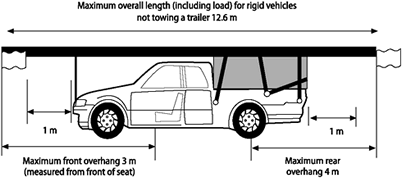A. 1m
 What is the maximum distance a load may overhang your vehicle behind the rear axle?
What is the maximum distance a load may overhang your vehicle behind the rear axle?
A. 1m
B. 2m
C. 3m
D. 4m
Vehicles following you must judge the distance to your vehicle so that they can stop in time. Long projecting loads (particularly very narrow ones) have a small focal point and they are difficult to judge. This means that if the vehicle in front stops, the vehicle behind could run into the load which could act like a spear through the windscreen.
For this reason any load protruding more than one metre behind must carry a flag, as mentioned above. Even protruding wide loads must have a flag.
A narrow load also makes it more difficult for other drivers to pull in behind on a dual carriageway - the load could be small in relation to the vehicle that's carrying it, and might be mounted high. Other drivers may not be expecting this and our peripheral vision above horizontal is not very good.
Any load hanging over the end of the vehicle will be unsupported and could flex. It also shifts the balance of the vehicle towards the back. In extreme cases this could affect the steering performance of the vehicle, but the load would have to be quite heavy for this to occur.
Make sure any load extending out the back is tied down tightly so that it doesn't bounce free. Also check that you are not exceeding the maximum 12.6m length for a rigid vehicle.

A vehicle must not have a load that protrudes too far because there are dangers when turning. The ends of the load will follow a wider arc than the back of the vehicle (and this applies equally to loads that overhang the front, too). Therefore as you turn a corner you risk the load hitting pedestrians, signs, road furniture, buildings and other vehicles.